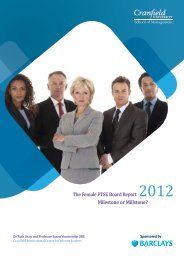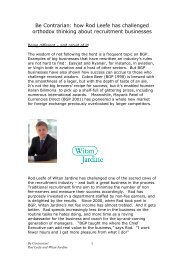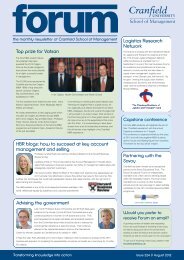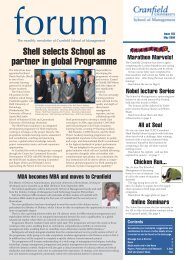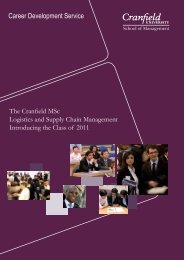Stakeholder Engagement - Cranfield School of Management ...
Stakeholder Engagement - Cranfield School of Management ...
Stakeholder Engagement - Cranfield School of Management ...
You also want an ePaper? Increase the reach of your titles
YUMPU automatically turns print PDFs into web optimized ePapers that Google loves.
Example: Different <strong>Stakeholder</strong>s,<br />
Different Levels <strong>of</strong> Trust<br />
A manager from a worldwide energy organisation<br />
described the various levels <strong>of</strong> personal commitment<br />
and confidence that different stakeholders brought to<br />
an engagement process that they facilitated.These<br />
various stakeholders responded very differently to the<br />
organisation’s efforts to engage with them,<br />
demonstrating the highly varied and diverse nature <strong>of</strong><br />
their stakeholders and the need to use alternative<br />
mechanisms to build trust with each:<br />
“What we found was as you expect some people were<br />
absolutely brilliant and it was quite clear that they were<br />
going to go on to bigger and brighter things and then there<br />
was quite a large number <strong>of</strong> people who might not have<br />
done absolutely brilliantly … but got a lot out <strong>of</strong> the<br />
process…and then I think there were some people who<br />
didn’t get much out <strong>of</strong> it, they weren’t really as interested<br />
in it as they originally thought or they found it frankly<br />
difficult and were surprised by the amount <strong>of</strong> work you<br />
have to do if you are going to do a piece <strong>of</strong> serious work,<br />
so perhaps some <strong>of</strong> them found that too intensive.A few,<br />
really a few, because they had serious preconceptions, they<br />
were doing it as a political act, they wanted to find the<br />
negatives – <strong>of</strong> course they did find some negatives, but<br />
largely they didn’t find the negatives that they were<br />
alleging, so a very few were thoroughly pissed <strong>of</strong>f, they<br />
weren’t in it to learn anyway.” 16<br />
There are several reasons why community and civil society<br />
stakeholders may trust an organisation more.The building <strong>of</strong><br />
trust is a crucial part <strong>of</strong> meaningful engagement resulting in<br />
information being shared both ways, communication becoming<br />
an enabler not a barrier, a significant willingness from both<br />
parties to understand the others’ viewpoint and enhanced ability<br />
to find commonalities.<br />
The following actions are examples <strong>of</strong> how an organisation can<br />
improve the non-financial aspects <strong>of</strong> relationships thus influencing<br />
how stakeholders, i.e. local communities, may view an<br />
organisation, allowing them to ‘trust’ the organisation more: 17<br />
❖ Acknowledge internally, and if appropriate publicly state, that<br />
you need the community’s trust to gain social licence to operate<br />
❖ Consult with the communities, as they need to feel that they<br />
are being heard and have a say in issues that concern them<br />
❖ Develop and put in place a mechanism or procedure for<br />
holding the organisation accountable for activities, e.g.<br />
periodic forums with community groups with a nominated<br />
senior member <strong>of</strong> staff to whom stakeholders can report<br />
concerns. It is important not to hide behind a website or<br />
email address, but rather give the organisation a personal<br />
face and stakeholders a way <strong>of</strong> talking to a person<br />
21<br />
Example: Destroying<br />
Trust is Easy<br />
A major beverage organisation invested significant time<br />
and energy over a series <strong>of</strong> months in building relations<br />
with a wide number <strong>of</strong> stakeholders in an emerging<br />
market as a way to establish open communication and<br />
relationships that the organisation could draw upon in<br />
future. In order to achieve this objective they dedicated<br />
significant head <strong>of</strong>fice and local staff time, as well as the<br />
services <strong>of</strong> various consultants and other external<br />
partners over a twelve-month period.They then<br />
allowed the relationships to lapse for 18 months during<br />
which time no follow up or further exchanges took<br />
place with the stakeholders.<br />
Following increased negative publicity regarding the<br />
actions <strong>of</strong> the organisation in the same market, the<br />
organisation decided to re-establish contact with<br />
stakeholders and requested that they sign a public<br />
letter expressing support for the actions and behaviour<br />
<strong>of</strong> the organisation.This produced some concern on<br />
the part <strong>of</strong> stakeholders, principally because <strong>of</strong> the long<br />
‘period <strong>of</strong> silence’ on the part <strong>of</strong> the organisation. Not<br />
only did the stakeholders decline to sign the letter, but<br />
the perceived poor corporate communications with<br />
stakeholders led to a significant deterioration <strong>of</strong> trust<br />
between organisation and stakeholders – not least<br />
because expectations raised in the initial introductory<br />
process were not fulfilled.<br />
The result <strong>of</strong> the whole process was to generate a<br />
greater level <strong>of</strong> scepticism in stakeholders than if no<br />
contact had been made at all.<br />
❖ Set up a way <strong>of</strong> keeping communities informed about the<br />
organisation’s future prospects or plans, whether through<br />
newsletter, website, email shots etc. Consider other<br />
platforms for communicating with them<br />
❖ Make sure that meetings with organisational staff are held<br />
regularly, take place when and where it is convenient for<br />
stakeholders, and are maintained on an informal and<br />
personal basis.<br />
❖ With your dealings ensure there is follow-through – assign a<br />
staff member to carry an issue to resolution and report on<br />
progress or difficulties, so that the organisation is known to<br />
be reliable and predictable, and to follow through on its<br />
promises<br />
❖ Encourage organisational staff to socialise informally with<br />
local people, by providing open days, tea & c<strong>of</strong>fee informal chats,<br />
away days for members <strong>of</strong> staff to community projects etc.<br />
❖ Don’t just deal with the big issues – make sure you capture<br />
little issues as well<br />
❖ Plan and then use appropriate language for the audience. Do<br />
not use language that is too heavy on business jargon<br />
❖ Identify and use shared history to find commonalities, such as<br />
where the organisation has grown with the community<br />
16 Interview with Author, June 2007<br />
17 Adapted from CDA Collaborative Learning Projects. 2004. <strong>Stakeholder</strong> Consultation Issue Paper. Corporate <strong>Engagement</strong> Project<br />
3<br />
Building Trust



